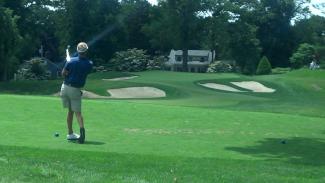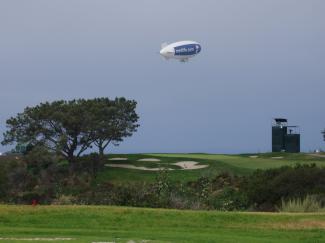Featured Golf News
Future U.S. Open Venues mix Links Golf, Golden Age Architecture
Everyone complaining about capricious bounces, difficult greens and links golf courses might want to just skip the U.S. Open altogether for a while, as the USGA is giving pros a steady diet of all three over the coming seven years.

Gil Hanse did a Nice Job Restoring LACC
Gargantuan green undulations, cloak-and-dagger claustrophobia while walking down fairways single file, and thick six-inch rough are the norm at the U.S. Open. But in the coming years the mix of Golden Age architecture and seaside or inland links golf will be especially good as the USGA revisits several permanent members of the unofficial U.S. Open Rota, while introducing us to new venues that have no shortage of buzz-worthy attributes. Let's take a closer look at the future U.S. Open sites that will follow Chambers Bay
and get excited, because they are all winners:
2016 - Oakmont, Oakmont, Pa. - Here's a sure bar bet winning question for you: What do Gene Sarazen, Sam Snead, Ben Hogan, Jack Nicklaus, Ernie Els and Paula Creamer all have in common? They all won majors at Oakmont.
The toughest of the tough, "Oakmonster" has hosted eight previous U.S. Opens (more than any other golf course), three PGA Championships, five U.S. Amateurs, and a Women's Open. But no other course except for Winged Foot has as much of a devastating synergy of history and misery as Oakmont.
"The members there are crazy," shrieked a freaked-out Lee Trevino in an old interview. "They think it's the U.S. Open every day!," and he's right. It's not enough that the greens have even more severe undulations than Augusta. It's not enough that the entire course is side-hill lies on wickedly canted fairways. It isn't enough that it has Brobdingnagian length. No, they have to play it every day at 26 on the Stimp and with 24-inch rough. And don't go into the long grass because the Velociraptors will get you. What was it Sam Neill said? The point is
you are alive when they start to eat you.
"There's no water at Oakmont and no real forced carries. It's just a bastard of a course," added veteran Pittsburgh sportswriter and Cybergolf columnist Marino Parascenzo. "[There's] no trees or ravines or waterfalls, but you stagger off the end and ask, 'What the hell just happened?' "
"It is likely America's toughest tournament venue," added golf expert Bruce Moulton. It may well be, all the while also being revered as a century-old, Golden Age masterpiece.
2017 - Erin Hills, Hartford, Wisc. - Poor Ron Whitten. If the haters can't like Chambers Bay even though it borders Puget Sound, what hope is there for a more modest dunescape in the shadow of mighty Whistling Straits?

The Difficult Par-3 10th at Winged Point West
Erin Hills is similar to Chambers Bay in many ways - the most controversial being its elevation change. Like Chambers, there are several steep vertical ascents. It can also play as relentlessly long as Chambers Bay as well.
"It's hard," said Sports Illustrated's Gary Van Sickle. "With all the enormous hills tumbling up and down, it's one of the few courses where the players will really have to be in shape to have a chance. It's a real test of endurance,"
Also like Chambers Bay, it will be an unknown commodity to the players; the course will have only hosted the 2011 U.S. Amateur as a precursor.
2018 - Shinnecock Hills, Southampton, N.Y. - So I'll wake up in the summer house, go to National Golf Links of America, have a nice lobster roll for breakfast, play the front nine of National, store my clubs in a halfway house, walk through the gate, enter the media center, cover the day's play, then play the back nine of National before returning to the summer house. Add sushi, tequila and girl as needed.
***Looks skyward and thanks the Good Lord***
Oh, you wanna know about Shinny? It hosted the second ever U.S. Open in 1896, then disappeared for the length of a Bible. We never saw Shinny again until 1986 when Ray Floyd broke out of a logjam over the back nine on Sunday to win his only Open title. Sadly, the 100th anniversary of the U.S. Open in 1995 was won by flaccid and milquetoast Corey Pavin.

You Can't Walk Wholesale Sections
of Torrey Pines
Finally, Tom Meeks burned down the entire seventh hole in 2004 when Retief Goosen outlasted Phil Mickelson, who only yipped one putt, but it was on the 71st green.
Meeks was rightfully run out of town, and the brilliant theories of Mike Davis brought refreshing change to both the USGA and the U.S. Open setup. He brought both into the 21st Century.
2019 - Pebble Beach, Carmel, Calif. - It will be the 100th anniversary of Pebble Beach, hence changing the prior custom of always coming in a year ending in a zero. It will also be the sixth U.S. Open contested there since it burst onto the scene in 1972 when Jack Nicklaus nearly holed out a 1-iron on the brutally hard par-3 17th.
Since then the Opens have been a mixed bag; Watson stealing the '82 Open from Jack is one of the iconic moments in all sports, so much so that people forget how clutch he was the rest of the tournament. He made a gazillion feet of putts on the back nine and chipped in. According to legend, Nicklaus greeted him after the round by saying, "You little &@#%, you're really something!"
"People always talk about the cliffside holes, and those are spectacular, but the inland holes are excellent too," pointed out golf course architecture expert Ran Morrissett in a prior interview. Nos. 14-16, in particular, are a terrific stretch.
Still, they do have to trick up Pebble Beach to suppress scoring. The greens sometimes exceed 14 on the Stimp, the rough will be six inches thick in places, and the fairways will be supermodel-thin. Then there's the ice plant: thick as pachysandra, and clingier than a cat's claws on a wool sweater. It's a half-stroke penalty at least if you get in it. And if the wind starts howling, scores soar well into the 80s.
2020 - Winged Foot, Mamaroneck, N.Y. - It's not just a golf course, it's an index of American history and society, perhaps the greatest club in America, and unquestionably the Yankee Stadium of Golf. It's also Castle Dracula to the greatest names in the game, as only Winged Foot rivals Oakmont and Carnoustie for major championship anguish.
And won't the Phil Mickelson interviews leading up to the tournament be interesting? (Especially if he comes into the tournament still missing the U.S. Open to complete the Grand Slam
.)
2021 - Torrey Pines, La Jolla, Calif. - I'm of two minds about returning to Torrey Pines. It just isn't that interesting of a golf course. It's pretty, but there's not much strategy to speak of. It's impossible to move around as the ocean hems you in on one side and the canyons on the other, so everyone complaining that Chambers Bay was too tough on spectators has nothing to say once they get a load of Torrey. Let's compare:
Time elapsed from parking the car to getting in the gate:
Torrey: 35-90 minutes
Chambers: 5 minutes
Time Needed to walk across the golf course:
Torrey: 90 minutes
Chambers: 95 minutes
Holes roped off as inaccessible:
Torrey: 7
Chambers: 6
Cul-de-sacs:
Torrey: Too many to count
Chambers: Almost as many
You get the idea
I remember getting boxed in by the TV grouping of Tiger, Phil, and Adam Scott in 2008 and it took me 90 minutes to extricate myself from the maze of ropes and crosswalks the USGA set up like it was a catacombs in Crete.
Still, the 2008 Open was riveting golf (although it wouldn't have been had Tiger not triple-bogeyed the first hole every day). And Rocco Mediate was hilarious playing the comic relief to Tiger's straight man. His three late birdies in the playoff to take the lead late was stirring. Plus the weather is usually sublime.
2022 - Los Angeles Country Club, Calif. - The whole golf world is abuzz with the addition of this George Thomas design to the list of future hosts.
"It's the best inner-city golf course of any major championship venue," noted Golf World's Jaime Diaz.
"What Thomas accomplished between 1925 and 1928 constitutes the greatest burst by an architect in the history of the game. During that brief span
Thomas created Bel-Air, Riviera
and then oversaw the complete rebuild of the North Course," writes Morrissett on his website, Golf Club Atlas. "Born and raised on the East Coast, George Thomas was influenced by the Philadelphia School of Design and especially its two design monuments, Pine Valley and Merion. By the time Thomas moved to Los Angeles in 1919, he had built several courses back East. In 1921, the Los Angeles Country Club sought to upgrade its two courses that had been laid out by several members including Ed Tufts and Norm Macbeth."
By comparison, the future PGA Championship venues seem a little lackluster: Baltusrol is good, but Quail Hollow and Bellerive are underwhelming. Bethpage Black is a mud pit, and Trump Bedminster in New Jersey (2022) has the garish taste of Caligula meets Kim Kardashian.
Since launching his first golf writing website in 2004, http://jayflemma.thegolfspace.com, Jay Flemma 's comparative analysis of golf designs and knowledge of golf course architecture and golf travel have garnered wide industry respect. In researching his book on America's great public golf courses (and whether they're worth the money), Jay has played over 420 nationally ranked public golf courses in 40 different states, and covered seven U.S. Opens and six PGA Championships, along with one trip to the Masters. A four-time award-winning sportswriter, Jay was called the best sports poet alive by both Sports Illustrated and NBC Sports writers and broadcasters. Jay has played about 3 million yards of golf - or close to 2,000 miles. In addition to Cybergolf, his pieces on travel and architecture appear in Golf Observer (www.golfobserver.com), PGA.com, Golf Magazine and other print magazines. When not researching golf courses for design, value and excitement, Jay is an entertainment, copyright, Internet and trademark lawyer and an Entertainment and Internet Law professor in Manhattan. His clients have been nominated for Grammy and Emmy awards, won a Sundance Film Festival Best Director award, performed on stage and screen, and designed pop art for museums and collectors. Jay lives in Forest Hills, N.Y., and is fiercely loyal to his alma maters, Deerfield Academy in Massachusetts and Trinity College in Connecticut.
Story Options
 |
Print this Story |
